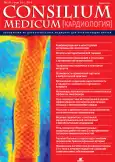Vozmozhnost' rasshireniya primeneniya predstavitelya gruppy sartanov olmesartana v ambulatornoy praktike
- Authors: Chukaeva I.I1, Solov'eva M.V1, Orlova N.V1, Spiryakina Y.G1
-
Affiliations:
- ГБОУ ВПО РНИМУ им. Н.И.Пирогова Минздрава России, Москва
- Issue: Vol 16, No 10 (2014)
- Pages: 57-60
- Section: Articles
- URL: https://journals.rcsi.science/2075-1753/article/view/94164
- ID: 94164
Cite item
Full Text
Abstract
Full Text
##article.viewOnOriginalSite##About the authors
I. I Chukaeva
ГБОУ ВПО РНИМУ им. Н.И.Пирогова Минздрава России, МоскваКафедра поликлинической терапии №2 лечебного факультета
M. V Solov'eva
ГБОУ ВПО РНИМУ им. Н.И.Пирогова Минздрава России, МоскваКафедра поликлинической терапии №2 лечебного факультета
N. V Orlova
ГБОУ ВПО РНИМУ им. Н.И.Пирогова Минздрава России, МоскваКафедра поликлинической терапии №2 лечебного факультета
Ya. G Spiryakina
ГБОУ ВПО РНИМУ им. Н.И.Пирогова Минздрава России, МоскваКафедра поликлинической терапии №2 лечебного факультета
References
- ESH/ESC Guidelines for the management of arterial hypertension TheTask Force for the management ofarterial hypertension of the European Society of Hypertension (ESH) and of the European Society of Cardiology (ESC). J Hypertens 2013; 31: 1281-357.
- Березин А.Е. Клиническая эффективность и безопасность применения олмесартана - нового антагониста рецепторов к ангиотензину II - у пациентов с артериальной гипертензией. http://www.umj.com.ua
- Aoki H, Izumo S, Sadoshima J. Angiotensin II activates RhoA in cardiac myocytes: A critical role of RhoA in angiotensin II-induced premyofibril formation. Circ Res 1998; 82: 666-76.
- Miura S, Kiya Y, Kanazawa T et al. Differential bonding interactions of inverse agonists of angiotensin II type 1 receptor in stabilizing the inactive state. Mol Endocrinol 2008; 22: 139-46.
- Fabia M.J, Abdilla N, Oltra R et al. Antihypertensive activity of angiotensin II AT 1 receptor antagonists: a systematic review of studies with 24h ambulatory blood pressure monitoring. J Hypertens 2007; 25: 1327-36.
- Zannad F, Fay R. Blood pressure - lowering efficacy of olmesartan relative to other angiotensin II receptor antagonists: an overview of randomized controlled studies. Fundam Clin Pharmacol 2007; 21 (2): 181-90.
- Smith D.H, Dubiel R, Jones M. Use of 24-hour ambulatory blood pressure monitoring to assess antihypertensive efficacy: a comparison of olmesartan medoxomil, losartan potassium, valsartan, and irbesartan. Am J Cardiovasc Drugs 2005; 5 (1): 41-50. Erratum in: Am J Cardiovasc Drugs 2005; 5 (3): 209.
- Rothwell P.M. Limitations of the usual blood - pressure hypothesis and importance of variability, instability, and episodic hypertension. Lancet 2010; 375: 938-48.
- Lea J, Greene T, Hebert L et al. The relationship between magnitude of proteinuria reduction and risk of end - stage renal disease: results of the African American study of kidney disease and hypertension. Arch Intern Med 2005; 165: 947-53.
- De Zeeuw D, Remuzzi G, Parving H.H et al. Albuminuria, a therapeutic target for cardiovascular protection in type 2 diabetic patients with nephropathy. Circulation 2004; 110: 921-7.
- Schmieder R.E, Mann J.F, Schumacher H et al. Changes in albuminuria predict mortality and morbidity in patients with vascular disease. J Am Soc Nephrol 2011; 22: 1353-64.
- Kunz R, Friedrich C, Wolbers M, Mann J.F. Meta - analysis: effect of monotherapy and combination therapy with inhibitors of the rennin angiotensin system on proteinuria in renal disease. Ann Intern Med 2008; 148: 30-48.
- Menne J, Ritz E, Ruilope L.M. The Randomized Olmesartan and Diabetes Microalbuminuria Prevention (ROADMAP) Observational Follow-Up Study: Benefits of RAS Blockade With Olmesartan Treatment Are Sustained After Study Discontinuation. J Am Heart Assoc 2014.
- Haller H, Ito S, Jr Izzo J.L et al. ROADMAP Trial Investigators. Olmesartan for the delay or prevention of microalbuminuria in type 2 diabetes. N Engl J Med 2011; 364: 907-17.
- Zanchetti A. Blood pressure targets of antihypertensive treatment: up and down the J-shaped curve. Eur Heart J 2010; 31: 2837-40.
- Elias M.F, Wolf P.A, D`Agostino et al. Untreated blood pressure level is inversely reated to cognitive functioning: the Framingham Study. Am J Epidemiol 1993; 138 (6): 353-64.
- Tzourio C, Dufouil C, Ducimetiere P et al. Cognitive decline in individuals with high blood pressure: a longitudinal study in the elderly. EVA Study Group. Epidemiology of Vascular Aging. Neurology 1999; 53 (9): 1948-52.
- Ruitenberg A, Skoog I, Ott A et al. Blood pressure and risk of dementia: results from the Rotterdam study and the Gothenburg H-70 Study. Dement Geriatr Cogn Disord 2001.
- Шишкова В.Н. Профилактика деменции у пациентов с артериальной гипертензией. Трудный пациент. 2014; 4: 26-32.
- Гаврилова С.И., Калын Я.Б. Социально - средовые факторы и состояние психического здоровья пожилого населения. Вестн. РАМН. 2002; 9: 15-20.
- Ruitenberg A, Skoog I, Ott A et al. Blood pressure and risk of dementia: results from the Rotterdam study and the Gothenburg H-70 Study. Dement Geriatr Cogn Disord 2001.
- Fournier A. Cerebroprotection Mediated by Angiotensin II. A Hypothesis Supported by Recent Randomized Clinical Trials. J Am Coll Cardiol 2004; 43 (8): 1343-8.
- Danlof B, Devereux R.B, Kieldsen S.E et al. For the LIFE study group. Cardiovascular morbidity and mortality in the Losartan Intervention For Endpoint reduction in hypertension study (LIFE): a randomised trial against atenolol. Lancet 2002; 359: 995-1003.
- Pelisch N, Hosomi N, Ueno M. Blockade of AT1 Receptors Protects the Blood-Brain Barrier and Improves Cognition in Dahl Salt-Sensitive Hypertensive Rats. Am J Hypertens 2011; 24: 362-8.
- Mogi M, Tsukuda K. Inhibition of cognitive decline in mice fed a high - salt and cholesterol diet by the angiotensin receptor blocker, olmesartan. Neuropharmacology 2007; 53 (8): 899-905.
- Чукаева И.И., Орлова Н.В., Спирякина Я.Г. и др. Особенности динамики С-реактивного белка и цитокиновой активности у больных инфарктом миокарда и ее влияние на исходы и прогноз заболевания. Вестн. РГМУ. 2013; 2: 14-9.
- Inaba S, Iwai M, Furuno M et al. Continuous activation of renin - angiotensin system impairs cognitive function in renin/angiotensinogen transgenic mice. Hypertension 2009; 53: 356-62.
- Fliser D, Buchholz K, Haller H et al. Antiinflammatory effects of angiotensin II subtype 1 receptor blockade in hypertensive patients with microinflammation. Circulation 2004; 110: 1103-7.
- Smith R.D, Yokoyama H, Levy P.J et al. Non - invasive hemodynamic data reflect treatment effects on vascular remodeling. J Clin Hypertens 2007; 9: A145.
Supplementary files






